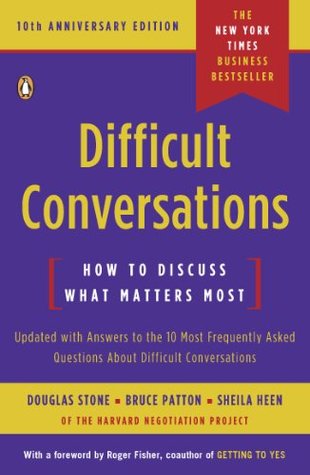More on this book
Community
Kindle Notes & Highlights
Read between
August 21 - September 25, 2022
Don’t Vent: Describe Feelings Carefully
Thinking that you shouldn’t feel as you do will rarely change the fact that you do.
Express the Full Spectrum of Your Feelings
share pure feelings (without judgments, attributions, or blame); save problem-solving until later; and don’t monopolize.
The biggest factor that contributes to a vulnerable identity is “all-or-nothing” thinking: I’m either competent or incompetent, good or evil, worthy of love or not.
You Will Make Mistakes.
Your Intentions Are Complex.
You Have Contributed to the Problem.
“I am constantly losing my balance. My skill lies in my ability to regain it.”
rather than trying to control the other person’s reaction, adopt the And Stance.
Imagine That It’s Three Months Or Ten Years From Now
If You Raise It: Three Purposes That Work
Learning Their Story
Expressing Your Views and Feelings
Problem-Solving Together
The Third Story would remove the judgment from the description, and instead describe the problem as a difference
Your purpose in opening the conversation is to invite the other person into a joint exploration. In the course of that exploration you’ll spend time in each side’s perspective, and then come back to adjust your own views based on what you’ve learned and what you’ve shared.
The simple advice about making requests is this: Don’t make it a demand. Instead, invite an exploration of whether a raise is fair, whether it makes sense.
From the information I have, I think I deserve one. [Here’s my reasoning.] I wonder how you see it?”
What to Talk About Explore where each story comes from “My reactions here probably have a lot to do with my experiences in a previous job. . . .” Share the impact on you “I don’t know whether you intended this, but I felt extremely uncomfortable when . . . .” Take responsibility for your contribution “There are a number of things I’ve done that have made this situation harder. . . .” Describe feelings “I’m anxious about bringing this up, but at the same time, it’s important to me that we talk about it. . . .” Reflect on the identity issues “I think the reason this subject hooks me is that I
...more
Three Skills: Inquiry, Paraphrasing, and Acknowledgment
Don’t Make Statements Disguised as Questions
Ask Open-Ended Questions
Ask for More Concrete Information
feelings crave acknowledgment. Like free radicals, feelings wander around the conversation looking for some acknowledgment to hook onto.
Acknowledge Before Problem-Solving
Acknowledging Is Not Agreeing
Self-knowledge and the belief that what you want to share is important will take you significantly further than eloquence and wit.
Start with What Matters Most
Don’t Rely on Subtext.
Avoid Easing In.
Don’t Present Your Conclusions as The Truth
Share Where Your Conclusions Come From
Don’t Exaggerate with “Always” and “Never”: Give Them Room to Change
You Can Reframe Anything
You can’t move the conversation in a more positive direction until the other person feels heard and understood.
It Takes Two to Agree
Say What Is Still Missing.
Say What Would Persuade You.
Ask What (If Anything) Would Persuade Them.
Ask Their Advice.
Invent Options
A Difficult Conversations Checklist Step 1: Prepare by Walking Through the Three Conversations 1. Sort out What Happened. • Where does your story come from (information, past experiences, rules)? Theirs? • What impact has this situation had on you? What might their intentions have been? • What have you each contributed to the problem? 2. Understand Emotions. • Explore your emotional footprint, and the bundle of emotions you experience. 3. Ground Your Identity. • What’s at stake for you about you? What do you need to accept to be better grounded? Step 2: Check Your Purposes and Decide Whether
...more
This highlight has been truncated due to consecutive passage length restrictions.


